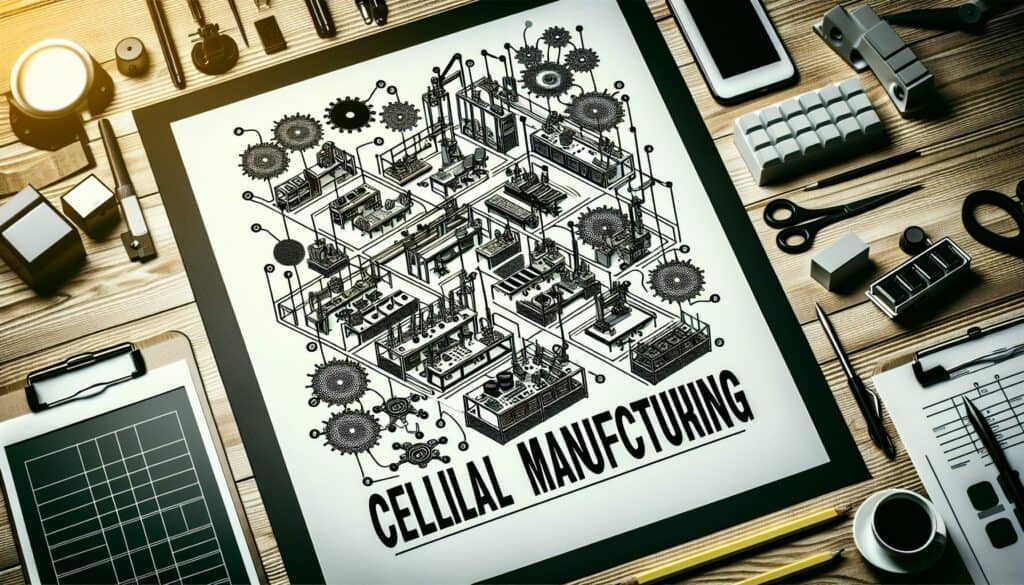Améliorer l'efficacité de la production en regroupant des machines dissemblables dans des cellules qui travaillent sur des produits ayant des exigences de traitement similaires (familles de pièces).
- Méthodologies : Clients et marketing, Économie
Fabrication cellulaire

Fabrication cellulaire
- Amélioration continue, Juste à temps (JIT), Production allégée, Amélioration des processus, Efficacité de la production, Gestion de la qualité, Cartographie de la chaîne de valeur
Objectif :
Comment il est utilisé :
- Les postes de travail et les équipements sont disposés en séquence afin de permettre un flux régulier de matériaux et de composants tout au long du processus de production, avec un minimum de transport et de retard. Une cellule est responsable de la fabrication d'une famille de pièces similaires.
Avantages
- Réduction des stocks de produits en cours de fabrication, des délais d'exécution et de la manutention des matériaux ; amélioration de la flexibilité, du moral des travailleurs et de la qualité ; gain de place dans l'usine.
Inconvénients
- La mise en œuvre peut être coûteuse (réorganisation de l'équipement, formation) ; elle nécessite une planification minutieuse et l'identification des familles de pièces ; l'utilisation des machines au sein d'une cellule peut être inférieure si elle n'est pas correctement équilibrée ; elle est vulnérable aux pannes si une machine d'une cellule tombe en panne.
Catégories :
- Lean Sigma, Fabrication, Conception de Produits
Idéal pour :
- Améliorer le flux et l'efficacité de la production de produits de grande variété et de faible à moyen volume en créant des unités de production spécialisées et ciblées.
Cellular manufacturing is particularly effective in industries such as automotive, electronics, and appliance manufacturing, where product lines often consist of a variety of components requiring customized assembly processes. This methodology is most beneficial during the design and development phases of new products, where early collaboration among engineers, designers, and production teams can lead to more efficient workflows. The implementation of cellular manufacturing typically begins with a thorough analysis of the product family to identify similarities and group related components, which enables the design of cells that can efficiently deal with variations in production. Participants including production supervisors, quality assurance personnel, and manufacturing engineers are crucial in defining the specific tasks and responsibilities within each cell. This collaborative approach not only enhances communication among team members but also fosters a sense of ownership and accountability, leading to improved worker morale. Furthermore, the layout of the production area can facilitate better ergonomic practices and minimize operator fatigue, which in turn translates to higher quality outputs and lower defect rates. Companies that incorporate cellular manufacturing may use techniques such as just-in-time inventory and principes de l'allégement to further enhance productivity, thereby reducing costs associated with excess inventory and prolonging lead times. Continuous improvement initiatives, like Kaizen, are often applied alongside cellular manufacturing, allowing teams to regularly assess and refine their processes to stay competitive in fast-paced markets.
Principales étapes de cette méthodologie
- Identify the family of similar parts to be produced.
- Design the cellular layout considering the workflow and space efficiency.
- Group equipment and workstations based on the sequence of operations needed.
- Assign team members to specific roles within the cell based on skill sets.
- Implement standardized work procedures for each operation within the cell.
- Establish visual controls and tools to monitor workflow and quality.
- Conduct regular reviews and adjustments based on performance and feedback.
- Train staff on cell operation and encourage cross-training for flexibility.
- Iterate designs and processes based on efficiency metrics and product quality.
Conseils de pro
- Analyze process flow regularly to identify bottlenecks and balance workloads across workstations for optimal efficiency.
- Implement cross-training for workers to enhance flexibility, allowing easy movement between tasks and cells as demand fluctuates.
- Utilize performance metrics to assess cell effectiveness continuously, adjusting layout and resources based on real-time production data.
Lire et comparer plusieurs méthodologies, nous recommandons le
> Référentiel méthodologique étendu <
ainsi que plus de 400 autres méthodologies.
Vos commentaires sur cette méthodologie ou des informations supplémentaires sont les bienvenus sur le site web de la Commission européenne. section des commentaires ci-dessous ↓ , ainsi que toute idée ou lien en rapport avec l'ingénierie.
Contexte historique
1949
1950
1950
1960
1960
1960
1960
1940
1950
1950
1958
1960
1960
1960
1960
(si la date est inconnue ou n'est pas pertinente, par exemple "mécanique des fluides", une estimation arrondie de son émergence notable est fournie)















Articles Similaires
Questionnaires sur les troubles musculo-squelettiques
Tests à plusieurs variables (MVT)
Analyse de régression multiple
Systèmes de capture de mouvement
Méthode MoSCoW
Test de la médiane de Mood